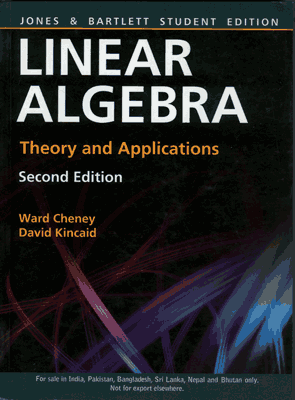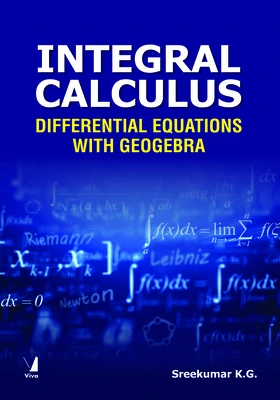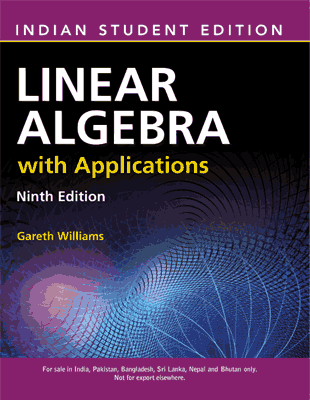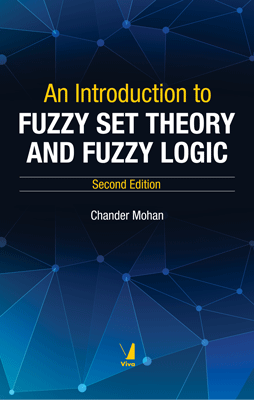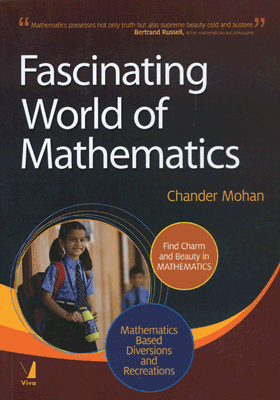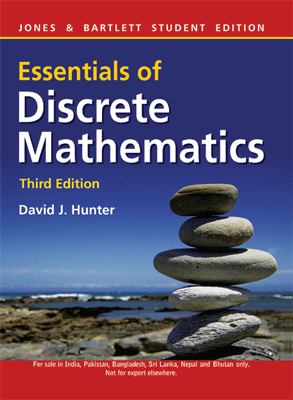Linear Algebra: Theory and Applications, 2/e
Linear Algebra: Theory and Applications, 2/e
₹895.50 ₹995.00 Save: ₹99.50 (10%)
Go to cartISBN: 9789380853826
Bind: Paperback
Year: 2017
Pages: 648
Size: Other mm
Publisher: Jones & Bartlett Learning
Published in India by: Jones & Bartlett India
Exclusive Distributors: Viva Books
Sales Territory: India, Nepal, Pakistan, Bangladesh, Sri Lanka
Description:
Ward Cheney and David Kincaid have developed Linear Algebra: Theory and Applications, Second Edition, a multi-faceted introductory textbook, which was motivated by their desire for a single text that meets the various requirements for differing courses within linear algebra. For theoretically oriented students, the text guides them as they devise proofs and deal with abstractions by focusing on a comprehensive blend between theory and applications For application-oriented science and engineering students, it contains numerous exercises that help them focus on understanding and learning not only vector spaces, matrices, and linear transformations, but uses of software tools available for applied linear algebra. With its flexible design, it is an ideal textbook for instructors who wish to make their own choice regarding what material to emphasize, and to accentuate those choices with homework assignments from a large variety of exercises both in the text and online.
New and Key Features of the Second Edition:
• New General Exercises and Computer Exercises have been added to nearly all sections throughout the text.
• Thousands of exercises both True/False and multiple-choice, are included online and within the Student Resource Manual.
• The authors encourage students to utilize one of the powerful mathematical software tools, such as MATLAB • , Maple , or mathematica to assist in solving exercises.
• Numerous examples throughout the text show how problems from engineering, biology, natural Science, and demography can be solved using linear algebra.
• A Student Resource Manual provides worked solutions to selected exercises from the text as well as additional exercises.
Target Audience:
This book will be useful to all students of mathematics, science and engineering professionals with potential of using linear algebra as a tool for solving mathematical problems in their profession.
Contents:
Preface
CHAPTER 1: SYSTEMS OF LINEAR EQUATIONS
• 1.1 Solving Systems of Linear Equations • Linear Equations • Systems of Linear Equations • General Systems of Linear Equations • Gaussian Elimination • Elementary Replacement and Scale Operations • Row-Equivalent Pairs of Matrices • Elementary Row Operations • Reduced Row Echelon Form • Row Echelon Form • Intuitive Interpretation • Application: Feeding Bacteria • Mathematical Software • Algorithm for the Reduced Row Echelon Form • Summary • Key Concepts • General Exercises • Computer Exercises
• 1.2 Vectors and Matrices • Vectors • Linear Combinations of Vectors • Matrix • Vector Products • The Span of a Set of Vectors • Interpreting Linear Systems • Row-Equivalent Systems • Consistent and Inconsistent Systems • Caution • Application: Linear Ordinary Differential Equations • Application: Bending of a Beam • Mathematical Software • Summary • Key Concepts • General Exercises • Computer Exercises
• 1.3 Kernels, Rank, Homogeneous Equations • Kernel or Null Space of a Matrix • Homogeneous Equations • Uniqueness of the Reduced Row Echelon Form • Rank of a Matrix • General Solution of a System • Matrix • Matrix Product • Indexed Sets of Vectors: Linear Dependence and Independence • Using the Row-Reduction Process • Determining Linear Dependence or Independence • Application: Chemistry • Summary • Key Concepts • General Exercises • Computer Exercises
CHAPTER 2: VECTOR SPACES
• 2.1 Euclidean Vector Spaces • n-Tuples and Vectors • Vector Addition and Multiplication by Scalars • Properties of Rn as a Vector Space • Linear Combinations • Span of a Set of Vectors • Geometric Interpretation of Vectors • Application: Elementary Mechanics • Application: Network Problems, Traffic Flow • Application: Electrical Circuits • Summary • Key Concepts • General Exercises • Computer Exercises
• 2.2 Lines, Planes, and Hyperplanes • Line Passing Through Origin • Lines in R2 • Lines in R2 • Planes in R2 • Lines and Planes in Rn • General Solution of a System of Equations • Application: The Predator • Prey Simulation • Application: Partial-Fraction Decomposition • Application: Method of Least Squares • Summary • Key Concepts • General Exercises • Computer Exercises
• 2.3 Linear Transformations • Functions,Mappings, and Transformations • Domain, Co-domain, and Range • Various Examples • Injective and Surjective Mappings • Linear Transformations • Using Matrices to Define Linear Maps • Injective and Surjective Linear Transformations • Effects of Linear Transformations • Effects of Transformations on Geometrical Figures • Composition of Two Linear Mappings • Application: Data Smoothing • Summary • Key Concepts • General Exercises • Computer Exercises
• 2.4 General Vector Spaces • Vector Spaces • Theorems on Vector Spaces • Various Examples • Linearly Dependent Sets • Linear Mapping • Application: Models in Economic Theory • Summary • Key Concepts • General Exercises • Computer Exercises
CHAPTER 3: MATRIX OPERATIONS
• 3.1 Matrices • Matrix Addition and Scalar Multiplication • Matrix • Matrix Multiplication • Pre-multiplication and Post-multiplication • Dot Product • Special Matrices • Matrix Transpose • Symmetric Matrices • Skew • Symmetric Matrices • Non-commutativity of Matrix Multiplication • Associativity Law for Matrix Multiplication • Linear Transformations • Elementary Matrices • More on the Matrix • Matrix Product • Vector • Matrix Product • Application: Diet Problems • Dangerous Pitfalls • Summary • Key Concepts • General Exercises • Computer Exercises
• 3.2 Matrix Inverses • Solving Systems with a Left Inverse • Solving Systems with a Right Inverse • Analysis • Square Matrices • Invertible Matrices • Elementary Matrices and LU Factorization • Computing an Inverse • More on Left and Right Inverses of Non-square Matrices • Invertible Matrix Theorem • Application: Interpolation • Mathematical Software • Summary • Key Concepts • General Exercises • Computer Exercises
CHAPTER 4: DETERMINANTS
• 4.1 Determinants: Introduction • Properties of Determinants • An Algorithm for Computing Determinants • Algorithm without Scaling • Zero Determinant • Calculating Areas and Volumes • Mathematical Software • Summary • Key Concepts • General Exercises • Computer Exercises
• 4.2 Determinants: Properties • Minors and Cofactors • Work Estimate • DirectMethods for Computing Determinants • Properties of Determinants • Cramer's Rule • Planes in R3 • Computing Inverses Using Determinants • Vandermonde Matrix • Application: Coded Messages • Mathematical Software • Review of Determinant Notation and Properties • Summary • Key Concepts • General Exercises • Computer Exercises
CHAPTER 5: VECTOR SUBSPACES
• 5.1 Column, Row, and Null Spaces • Introduction • Linear Transformations • Revisiting Kernels and Null
Spaces • The Row Space and Column Space of a Matrix • Caution • Summary • Key Concepts • General Exercises • Computer Exercises • 5 Bases and Dimension • Basis for a Vector Space • Coordinate Vector • Isomorphism and Equivalence Relations • Finite-Dimensional and Infinite-Dimensional Vector Spaces • Linear Transformation of a Set • Dimensions of Various Subspaces • Caution • Summary • Key Concepts • General Exercises • Computer Exercises • 5 Coordinate Systems • Coordinate Vectors • Changing Coordinates • Linear Transformations • Mapping a Vector Space into Itself • Similar Matrices • More on Equivalence Relations • Further Examples • Summary • Key Concepts • General Exercises • Computer Exercises
CHAPTER 6: EIGENSYSTEMS
• 6.1 Eigenvalues and Eigenvectors • Introduction • Eigenvectors and Eigenvalues • Using Determinants in Finding Eigenvalues • Linear Transformations • Distinct Eigenvalues • Bases of Eigenvectors • Application: Powers of a Matrix • Characteristic Equation and Characteristic Polynomial • Diagonalization Involving Complex Numbers • Application: Dynamical Systems • Further Dynamical Systems in R2 • Analysis of a Dynamical System • Application: Economic Models • Application: Systems of Linear Differential Equations • Epilogue: Eigensystems without Determinants • Mathematical Software • Summary • Key Concepts • General Exercises • Computer Exercises •
CHAPTER 7: INNER-PRODUCT VECTOR SPACES
• 7.1 Inner-Product Spaces • Inner-Product Spaces and Their Properties • TheNormin an Inner-Product Space • Distance Function • Mutually Orthogonal Vectors • Orthogonal Projection • Angle between Vectors • Orthogonal Complements • Orthonormal Bases • Subspaces in Inner-Product Spaces • Application: Work and Forces • Application: Collision • Summary • Key Concepts • General Exercises • Computer Exercises
• 7.2 Orthogonality • Introduction • The Gram • Schmidt Process • Unnormalized Gram • Schmidt Algorithm • Modified Gram • Schmidt Process • Linear Least-Squares Solution • Gram Matrix • Distance from a Point to a Hyperplane • Mathematical Software • Summary • Key Concepts • General Exercises • Computer Exercises •
CHAPTER 8: ADDITIONAL TOPICS
• 8.1 Hermitian Matrices and the Spectral Theorem • Introduction • Hermitian Matrices and Self-Adjoint Mappings • Self-Adjoint Mapping • The Spectral Theorem • Unitary and Orthogonal Matrices • The Cayley • Hamilton Theorem • Quadratic Forms • Application: World Wide Web Searching • Mathematical Software • Summary • Key Concepts • General Exercises • Computer Exercises
• 8.2 Matrix Factorizations and Block Matrices • Introduction • Permutation Matrix • LU-Factorization • LLT -Factorization: Cholesky Factorization • LDLT-Factorization • QR-Factorization • Singular-Value Decomposition (SVD) • Schur Decomposition • PartitionedMatrices • Solving a System Having a • • Block Matrix • Inverting a 2 • • 2 BlockMatrix • Application: Linear Least-Squares Problem • Mathematical Software • Summary • Key Concepts • General Exercises • Computer Exercises
• 8.3 Iterative Methods for Linear Equations • Introduction • Richardson Iterative Method • Jacobi Iterative Method • Gauss • Seidel Method • Successive Overrelaxation (SOR) Method • Conjugate Gradient Method • Diagonally Dominant Matrices • Gerschgorin's Theorem • Infinity Norm • Convergence Properties • Power Method for Computing Eigenvalues • Application: Demographic Problems, Population Migration • Application: Leontief Open Model • Mathematical Software • Summary • Key Concepts • General Exercises • Computer Exercises
APPENDIX A: DEDUCTIVE REASONING AND PROOFS • Introduction • Deductive Reasoning and Direct Verification • Implications • Method of Contradiction • Mathematical Induction • Truth Tables • Subsets and de Morgan Laws • Quantifiers • Denial of a Quantified Assertion • Some More Questionable • • Proofs • Summary Appendix • Key Concepts Appendix • General Exercises
APPENDIX B: COMPLEX ARITHMETIC • Complex Numbers and Arithmetic • Fundamental Theorem of Algebra • Abel • Ruffini Theorem
• ANSWERS/HINTS FOR GENERAL EXERCISES • REFERENCES • INDEX
About the Author:
Ward Cheney, PhD-University of Texas, Austin research interests are in approximation theory and numerical analysis. His book Introduction to Approximation Theory has been in print for many years and has been translated into several languages. His book A Course in Approximation Theory, co-authored with Professor Will Light, is a graduate level textbook. Cheney has taught mathematics courses at the University of Kansas, Iowa State University, University of California at Los Angeles, Michigan State University, Lund University (Sweden), and The University of Texas at Austin. He has been the author or co-author of over 100 research papers.
David R. Kincaid, PhD-University of Texas, Austin research interests are in scientific computing, especially parallel computing. He was one of the original co-authors for the BLAS: Basic Linear Algebra Subprograms. Previously co-authored books with Ward Cheney include Numerical Mathematics and Computing, currently in it's 6th edition, and Numerical Analysis: Mathematics of Scientific Computing, in it's 3rd edition. They have been translated into several languages as well as Braille and recorded for the visually impaired. Kincaid has taught computer science and mathematics courses at Purdue University and The University of Texas at Austin. He has been the author or co-author of over 100 research papers.
